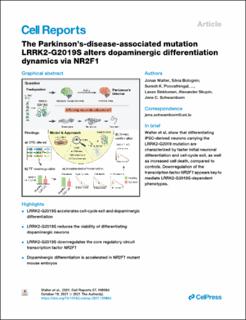| dc.contributor.author | Walter, Jonas | |
| dc.contributor.author | Bolognin, Silvia | |
| dc.contributor.author | Poovathingal, Suresh K. | |
| dc.contributor.author | Magni, Stefano | |
| dc.contributor.author | Gérard, Deborah | |
| dc.contributor.author | Antony, Paul M. A. | |
| dc.contributor.author | Nickels, Sarah L. | |
| dc.contributor.author | Salamanca, Luis | |
| dc.contributor.author | Berger, Emanuel | |
| dc.contributor.author | Smits, Lisa M. | |
| dc.contributor.author | Grzyb, Kamil | |
| dc.contributor.author | Perfeito, Rita | |
| dc.contributor.author | Hoel, Fredrik | |
| dc.contributor.author | Qing, Xiaobing | |
| dc.contributor.author | Ohnmacht, Jochen | |
| dc.contributor.author | Bertacchi, Michele | |
| dc.contributor.author | Jarazo, Javier | |
| dc.contributor.author | Ignac, Tomasz | |
| dc.contributor.author | Monzel, Anna S. | |
| dc.contributor.author | Gonzalez-Cano, Laura | |
| dc.contributor.author | Krüger, Rejko | |
| dc.contributor.author | Sauter, Thomas | |
| dc.contributor.author | Studer, Michèle | |
| dc.contributor.author | Pereira de Almeida, Luis | |
| dc.contributor.author | Tronstad, Karl Johan | |
| dc.contributor.author | Sinkkonen, Lasse | |
| dc.contributor.author | Skupin, Alexander | |
| dc.contributor.author | Schwamborn, Jens C. | |
| dc.date.accessioned | 2022-01-18T12:56:36Z | |
| dc.date.available | 2022-01-18T12:56:36Z | |
| dc.date.created | 2021-12-15T11:45:28Z | |
| dc.date.issued | 2021 | |
| dc.identifier.issn | 2211-1247 | |
| dc.identifier.uri | https://hdl.handle.net/11250/2837947 | |
| dc.description.abstract | Increasing evidence suggests that neurodevelopmental alterations might contribute to increase the susceptibility to develop neurodegenerative diseases. We investigate the occurrence of developmental abnormalities in dopaminergic neurons in a model of Parkinson’s disease (PD). We monitor the differentiation of human patient-specific neuroepithelial stem cells (NESCs) into dopaminergic neurons. Using high-throughput image analyses and single-cell RNA sequencing, we observe that the PD-associated LRRK2-G2019S mutation alters the initial phase of neuronal differentiation by accelerating cell-cycle exit with a concomitant increase in cell death. We identify the NESC-specific core regulatory circuit and a molecular mechanism underlying the observed phenotypes. The expression of NR2F1, a key transcription factor involved in neurogenesis, decreases in LRRK2-G2019S NESCs, neurons, and midbrain organoids compared to controls. We also observe accelerated dopaminergic differentiation in vivo in NR2F1-deficient mouse embryos. This suggests a pathogenic mechanism involving the LRRK2-G2019S mutation, where the dynamics of dopaminergic differentiation are modified via NR2F1. | en_US |
| dc.language.iso | eng | en_US |
| dc.publisher | Cell Press | en_US |
| dc.rights | Navngivelse 4.0 Internasjonal | * |
| dc.rights.uri | http://creativecommons.org/licenses/by/4.0/deed.no | * |
| dc.title | The Parkinson's-disease-associated mutation LRRK2-G2019S alters dopaminergic differentiation dynamics via NR2F1 | en_US |
| dc.type | Journal article | en_US |
| dc.type | Peer reviewed | en_US |
| dc.description.version | publishedVersion | en_US |
| dc.rights.holder | Copyright 2021 The Author(s) | en_US |
| dc.source.articlenumber | 109864 | en_US |
| cristin.ispublished | true | |
| cristin.fulltext | original | |
| cristin.qualitycode | 2 | |
| dc.identifier.doi | 10.1016/j.celrep.2021.109864 | |
| dc.identifier.cristin | 1968800 | |
| dc.source.journal | Cell reports | en_US |
| dc.identifier.citation | Cell reports. 2021, 37 (3), 109864 | en_US |
| dc.source.volume | 37 | en_US |
| dc.source.issue | 3 | en_US |

